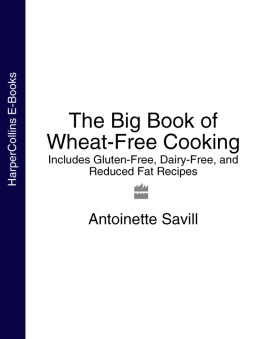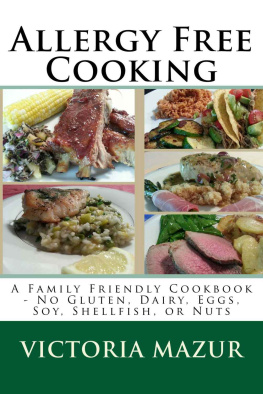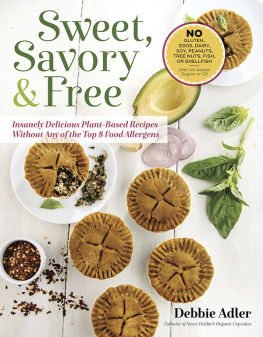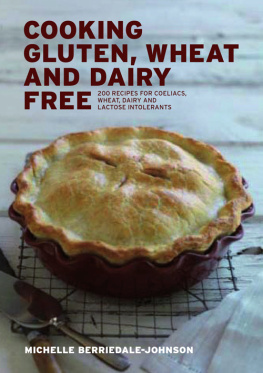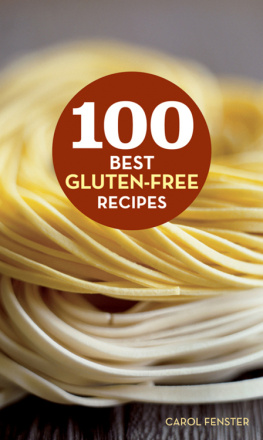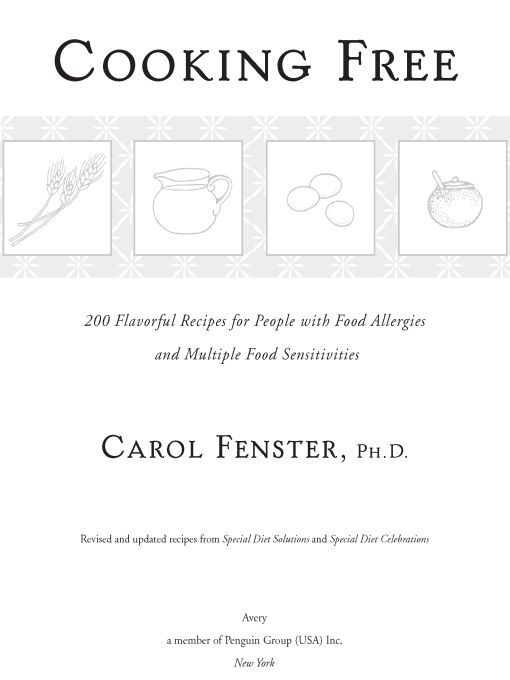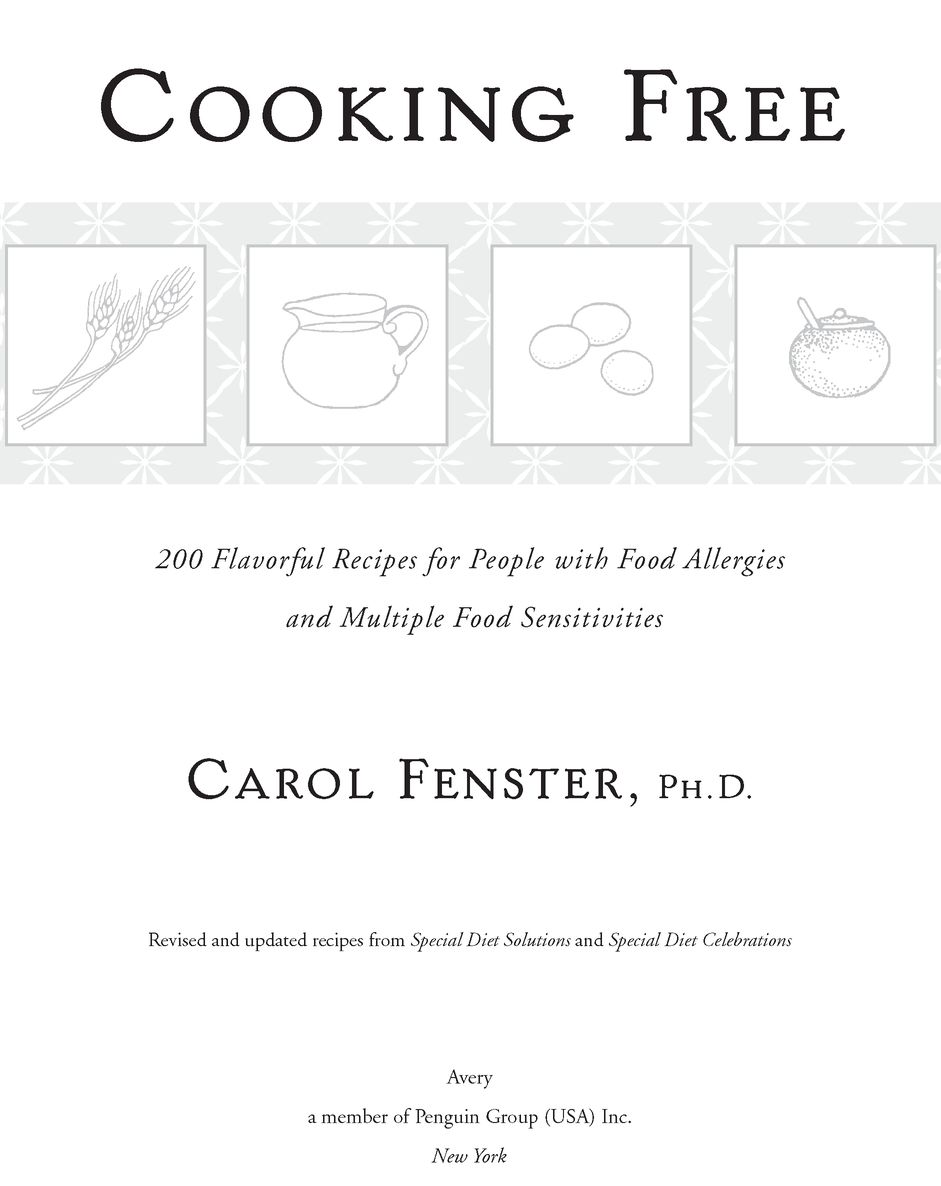Table of Contents
What People Are Saying AboutCooking Free
When I was first placed on a gluten-free diet, I was lost as to how to survive in this gluten-filled world. Your cookbook provided much-needed guidance for cooking, baking, and eating wellgluten free.
Peggy Wagener, Publisher, Living Without, a lifestyle guide for people with allergies and food sensitivities
After working as a nutritionist for twenty years, I have found no allergy cookbook that compares to this wonderful reference. It contains the best-tasting recipes you will ever find!
Ellen Speare, B.S., Nutritionist
A normal cookbook for special people.
Ann Whelan, Publisher, Gluten-Free Living magazine
Well written, informative, appealing, unique.
Sheila E. Crowe, M.D., Associate Professor, Department of Internal Medicine, University of Virginia
I like the idea of targeting dietary needs for special occasions.
Joanne M. Vitanza, M.D., formerly of Colorado Allergy and Asthma Centers, P.C.
A great source of information. Much needed by our patients.
Dianna S. Hayton, R.N., Patient Educator, Colorado Allergy and Asthma Centers, P.C.
You offer extra tidbits that ensure success. A personal invitation to cooking success.
Nancy Carol Sanker, OTR, former Education and Support Group Project Director, Asthma and Allergy Foundation of America
To Larry, Brett, Helke, and Keene,
and in loving memory of Jeanne Von Wyl
ACKNOWLEDGMENTS
Food is usually the centerpiece of any social gathering. This cookbook was a joy to write because I know it will be used to make the food served appropriate for everyone with food sensitivities. I am deeply indebted to the following people who gave so generously of their time so you could safely take part in these gatherings.
To those who helped with testing recipes and providing excellent feedback, I truly appreciate your inputand please extend my thanks to your family and friends who lent their taste buds to the tasting process: Jane Dennison-Bauer; Julie Cary; Mary Courtney; Sandy Dempsey; Terri Ditmer; Laura Dolson; Donna Franz; Caroline Herdle; Jane Holcomb; Ruth Horelica; Janene Lenard; Alicia Pitzer; Janet Rinehart; Denise Roth; Lynn Samuel, LPN; Judy Sarver; Chris Silker; Jenny View; Peggy Wagener; Anne Washburn; Cecile Weed; and Sue Weilgopolan.
To those who helped with reviewing the manuscript and providing extremely valuable feedback, I sincerely appreciate your help: Rosanne G. Ainscough, R.D., CDE, Diabetes Dietitian Educator; Mary Bonner, Technical Writer; Gail Bright, R.D., Colorado Allergy and Asthma Centers; Sheila E. Crowe, M.D., Department of Internal Medicine, University of Virginia; Kathy Gibbons, Ph.D., Healthy Actions; Leon Greos, M.D., Colorado Allergy and Asthma Centers, P.C.; Dianna S. Hayton, R.N., Patient Educator, Colorado Allergy and Asthma Centers, P.C.; Cynthia Kupper, R.D., Executive Director, Gluten Intolerance Group; Anne Munoz-Furlong, Founder, Food Allergy & Anaphylaxis Network; Janet Y. Rinehart, Chairman, Houston Celiac Sprue Support Group and Past President, CSA/USA, Inc.; Nancy Carol Sanker, OTR, former Education and Support Group Project Director, Asthma and Allergy Foundation of America; Ellen Speare, B.S., Clinical Nutritionist, formerly of Wild Oats Markets; Gail Spiegel, M.S., R.D., CDE; Joanne M. Vitanza, M.D., formerly of Colorado Allergy and Asthma Centers, P.C.; Peggy A. Wagener, publisher of Living Without magazine; Ann Whelan, publisher of Gluten-Free Living newsletter; and Maura Zazenski.
I am enormously grateful to Lisa Ekus, my wonderful, inspiring agent, for her guidance, support, and unflagging enthusiasm for my work. I want to thank John Duff, Rebecca Behan, and especially my editor, Kristen Jennings, at Avery for their invaluable feedback on the book at various stages of the way.
Finally, a very special thank-you to my familyhusband, Larry; son, Brett; daughter-in-law, Helke; and grandson, Keene. I love you all.
PREFACE
Managing a healthy diet can be challenging for anyone, but its all the more so when common ingredients like wheat, dairy, eggs, and cane sugar must be avoided because of food sensitivities, medical conditions, and other special diet needs. For the 11 million Americans with some sort of reaction to food, even a simple meal with family and friends can be downright dangerous.
In addition to being a culinary professional, I am a sociologist who is fascinated by the symbolism of food. Rituals associated with foodeven if just nightly suppers around the kitchen tablebecome the memories of a lifetime. And yet for those of us with food sensitivities, dining on any occasion can be risky. Even food we once ateand that everyone expects us to continue eatingis now off-limits. But the good news is that you can continue to eat these foodsif theyre prepared with appropriate substitutes for the problem ingredients. Fortunately, my training as a home economist and my own personal struggle with gluten intolerance have given me the technical ability to transform recipes into dishes that everyone can safely enjoy.
If youve read my first book, Wheat-Free Recipes & Menus: Delicious, Healthful Eating for People with Food Sensitivities (Avery, 2004), you know my story. I suffered from chronic sinusitis for decades until I learned to avoid my own particular food villainswheat and wheat-related grains. For someone raised on a farm in Nebraska and who married into a wheat-farming familycomplete with a father-in-law who is an internationally recognized expert on wheat cultivationthis was unsettling, to say the least.
The irony is that wheat caused my lifetime struggle with nasal congestion and stuffinessmaking me feel dull, groggy, and lethargic. For decades, I was plagued by chronic sinus infections requiring endless rounds of antibiotics. It always seemed like I was coming down with a cold, and my sinus infections were often accompanied by laryngitis and bronchitis. And my eighty-hour workweek as a corporate marketing executiveinterspersed with far too much transcontinental traveldidnt help.
I never suspected wheat as the culprit. I didnt understand that the proteins in wheatparticularly glutencan be toxic to many of us. I didnt associate my fondness for baked goodsbagels, fresh-baked bread, pasta, cakes, and cookieswith the chronic congestion. And I had no idea that wheat lurked in the most unsuspecting places, such as licorice candy. Or that wheat is actually related to barley, rye, spelt, and kamutwhich also must be avoided.
It took several decades for me to discover that wheat is my nemesis and that Im part of the 10 to 15 percent of Americans who cant eat it. In fact, when I was diagnosed I kept hoping the doctor was wrong and that he would eventually call me to say it was all a big mistake. To make matters worse, I didnt know anyone else who couldnt eat wheat, so I felt isolated. And, of course, my new wheat-free way of life was puzzling to my wheat-farming family.
After my diagnosis, I knew I had to take complete control over what I ate if I wanted to regain my health. So I began researching how I could prepare the same dishes I was accustomed to eating, while eliminating wheat as an ingredient. I learned which alternative flours were acceptable to my diet and how these flours perform in various recipes. Eventually I totally revamped my familys repertoire of dishes, and after a great deal of what my daughter-in-law calls dishes, discourse, and discovery, I mastered the gluten-free lifestyle. I decided to turn my recipes into a cookbook and founded my company, Savory Palate, Inc., with the mission of helping others eat well without gluten.



